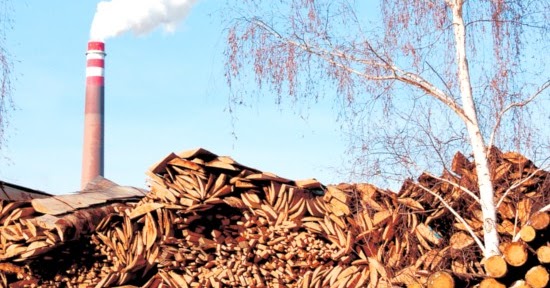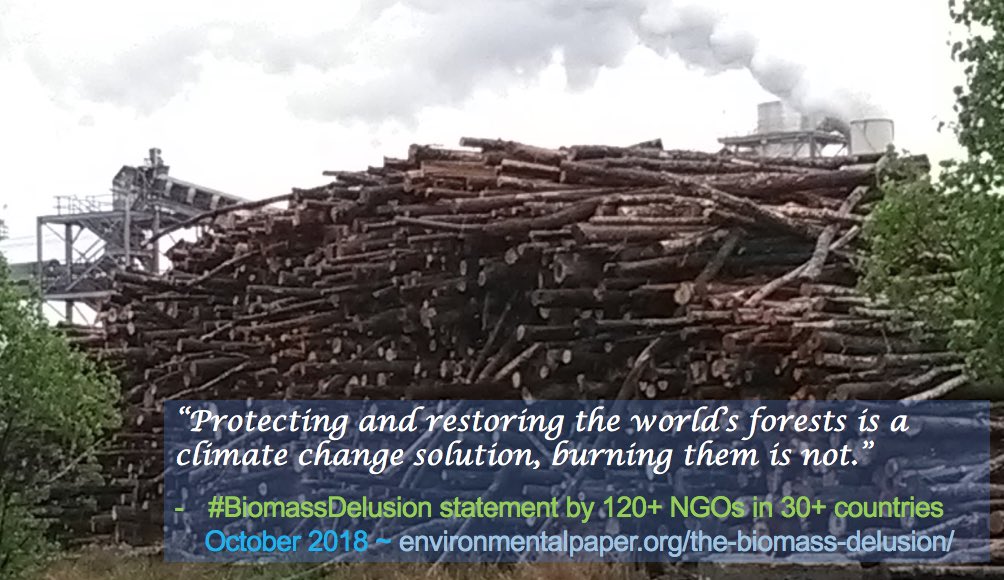
The EU’s classification of wood fuels
is accelerating the climate crisis.
Now, a key vote can change that
Greta Thunberg and Others /Guardian UK
(September 8, 2022) — Next week the future of many of the world’s forests will be decided when members of the European parliament vote on a revised EU renewable energy directive. If the parliament fails to change the EU’s discredited and harmful renewables policy, European citizens’ tax money will continue to pay for forests around the globe to literally go up in smoke every day.
Europe’s directly elected representatives now have to choose: they can either save the EU’s “climate targets” with their legislative loopholes or they can begin saving our climate, because right now, that is not what EU targets are working towards.
Increasing volumes of wood pellets and other wood fuels are being imported from outside the EU to satisfy Europe’s growing appetite for burning forests for energy. This is an appetite that the existing EU renewable energy directive incentivises. It does this by classifying forest biomass on paper as zero-carbon emissions when in reality, burning forest biomass will produce higher emissions than fossil fuels during the coming decisive decades.
The interlinked crises of wars and rising food and energy prices underline the urgent need for policies that enable energy saving and energy efficiency, and the importance of decarbonising the EU’s energy sector. It should be obvious that decarbonising can only be done by using non-carbon energy sources. It is critical to phase out fossil fuels, but the energy sources we replace them with are just as important.
The EU’s renewable energy directive should apply solely to actual renewable energy forms – and forests are not renewable. Forests are ecosystems created by nature that cannot be replanted.
The Intergovernmental Panel on Climate Change states that we need to restore and preserve more forest ecosystems – but as internationally renowned scientists have warned, the EU’s renewable energy directive incentivises a daily loss of irreplaceable forest ecosystems in favour of the harmful replanting of new trees.
There is just not enough time for these tree plantations to regrow to be in line with the Paris agreement. Forest biomass takes minutes to burn, whereas it takes anywhere from decades to centuries for the climate and environmentally harmful tree plantations to resequester the carbon emitted. This equals decades of carbon debts that we do not have time for.
The same goes for the burning of what the industry calls forest residues, such as treetops and branches. Burning any part of the tree means burning carbon. When forestry residues come from an 80-year-old tree, it will take 80 years for an equivalent tree to regrow – and this is time we do not have.
For forest residues to become sustainable end-products, forestry needs to be sustainable in the first place; but this is not the case today. Most people would assume a few things about our forests based on what they’ve been told: first, that Europe has a fair amount of protected forests – and even if not yet as much as the EU has promised, that protection rates are at least moving in the right direction.
Other common misconceptions are that forestry is carried out sustainably, that predominantly climate-friendlywood products are produced, and that only forest residues are burned for energy.

In reality, none of this is true for the EU today. Strictly protected forests are being logged daily, half of what is logged in EU forests, not just residues, is burned as fuel. Certified and supposedly “sustainable” forestry causes increased emissions, a daily loss of biodiversity and a systematic violation of indigenous peoples’ rights in Europe’s Arctic regions.
The policy-driven conversion of forests to environmentally harmful tree plantations is threatening the way of life of indigenous Sámi communities. Their reindeer have survived the harsh arctic climate for time immemorial, but after only 60 years of so-called sustainable forestry, 71% of lichen-rich forests crucial for the survival of the reindeer have already disappeared in Sweden. Sámi communities are sounding the alarm: they are telling us “the reindeer are starving”.
Forests degraded by clearcutting are also more flammable, and in the midst of an accelerating climate crisis, this is a huge risk. This was clearly demonstrated by the out-of-control fires that broke out across Europe in the recent extreme heat, leading to a large-scale release of carbon, further intensifying climate breakdown.
We need to drastically reduce all types of greenhouse gas emissions, not only those from fossil fuels. In addition, and not instead of, we must remove carbon dioxide from the atmosphere. Instead of trusting non-existent, unreliable and expensive carbon capture technologies, the best way to do that is to protect and restore more forests. I
f we continuously log forests, there will always be more carbon in the atmosphere than if the forest had remained unlogged. Due to incentivised logging, the EU is already beginning to see the collapse of its carbon sinks in countries like Finland and Estonia.
We clearly need to move towards ecosystems-based forestry and away from today’s forestry model, which means thinning, clearcuts and the planting of industrial tree stands.
Such a shift would equal more sustainable rural jobs and lead to more climate-resilient forests, both of which are vital for a just transition. On that note, all subsidies given to burn forest biomass must be reallocated to true renewables such as offshore-wind, solar and geothermal.

Yet as things stand, the renewable energy directive creates a downward-facing negative spiral. We can, however, turn this around. Members of the European parliament have a precious window of opportunity and a duty.
They have until 1pm on Wednesday to table an amendment to remove forest biomass from the renewable energy directive. They can vote this change through on 13 September. They have 48 hours to do the right thing. If they fail, they will lock in decades of increased carbon emissions, biodiversity loss and human rights violations.
Posted in accordance with Title 17, Section 107, US Code, for noncommercial, educational purposes.